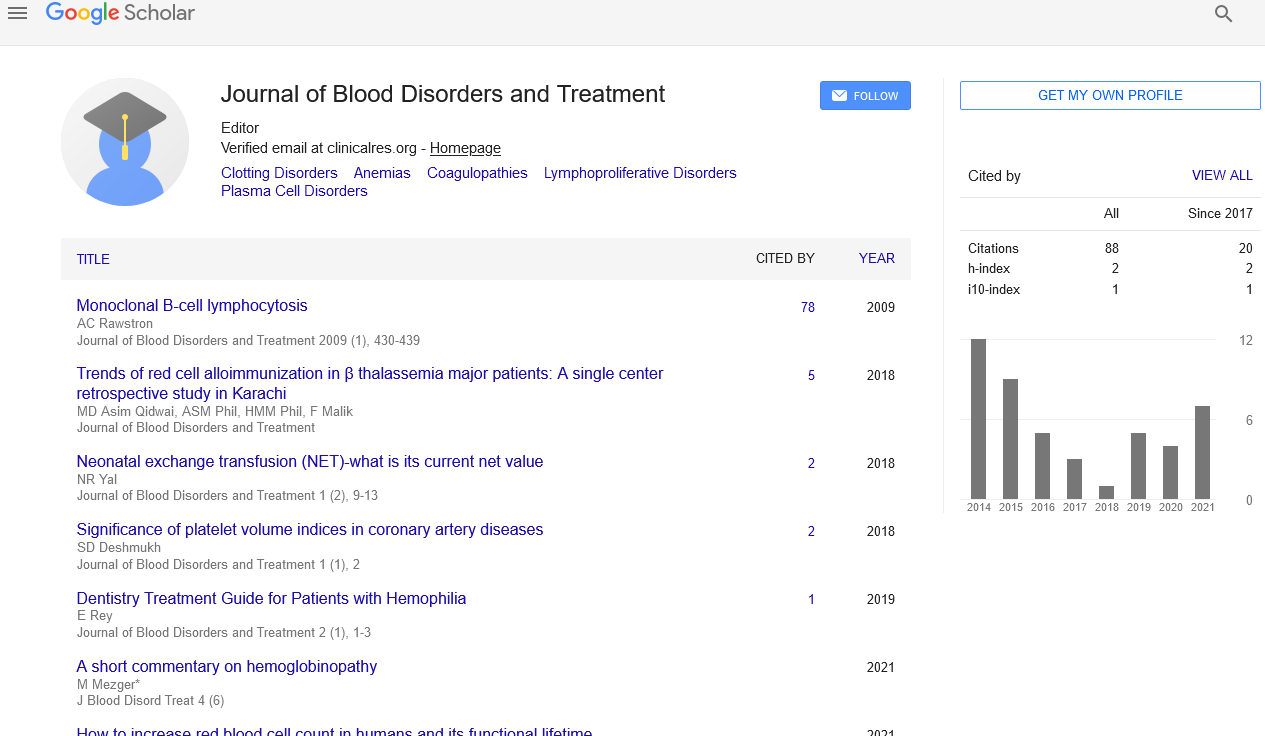Acquired haemophilia
Received: 04-Sep-2022, Manuscript No. puljbdt-23-6212; Editor assigned: 06-Sep-2022, Pre QC No. puljbdt-23-6212 (PQ); Accepted Date: Sep 20, 2022; Reviewed: 10-Sep-2022 QC No. puljbdt-23-6212 (Q); Revised: 12-Sep-2022, Manuscript No. puljbdt-23-6212 (R); Published: 30-Sep-2022, DOI: 10.37532/puljbdt.2022.5(5).01-02
Citation: Collins A. Acquired haemophilia. J. Blood Disord Treat. 2022; 5(5):01-02
This open-access article is distributed under the terms of the Creative Commons Attribution Non-Commercial License (CC BY-NC) (http://creativecommons.org/licenses/by-nc/4.0/), which permits reuse, distribution and reproduction of the article, provided that the original work is properly cited and the reuse is restricted to noncommercial purposes. For commercial reuse, contact reprints@pulsus.com
Abstract
An uncommon but severe bleeding condition is acquired haemophilia. The emergence of autoantibodies against one of the antihemophilic factors, most commonly factor VIII, is what causes it.
Keywords
Aldosterone; Hydrocortisone; Adrenaline
Introduction
Due to its rarity and the difficulty of the laboratory diagnosis, this illness is challenging to diagnose. To prevent the high morbidity and mortality linked to this condition, it must be quickly diagnosed and treated. This exercise reviews acquired haemophilia evaluation and treatment, with a focus on the inter professional team's involvement in diagnosing and treating patients with this condition. The most prevalent and serious hemorrhagic condition is known as haemophilia, which derives from the Greek words hemo (blood) and philia (love). Three kinds of haemophilia—A, B, and C—depend on the pathophysiology and are brought on by deficiencies in or dysfunctions of factors VIII, IX, and XI, respectively. It can be acquired, which is a rare variety, or it can be hereditary, which is more prevalent. Autoantibodies that form against a coagulation component cause acquired haemophilia. Most often, antibodies form against factor VIII, thus the term "Acquired Haemophilia A" (AHA). Due to this disorder's variable bleeding phenotype, the clinical picture can range from traumatic, life-threatening bleeding to mild or no bleeding propensity. It is sometimes only noticed after a surgical procedure, but in the majority of cases, it happens on its own without any obvious cause. Co-morbidities and concurrent medications, such as anti-platelet agents, may also affect the clinical profile in patients with AHA because they are frequently elderly, necessitating a personalised therapeutic strategy. Large hematomas, extensive ecchymosis, or severe mucosal bleeding, such as epistaxis, gastrointestinal bleeding, and haematuria, are common symptoms in symptomatic individuals. Spontaneous haemarthroses are unusual, in contrast to what occurs to patients with congenital haemophilia. Usually, women who take postpartum factor VIII antagonists have abnormal vaginal bleeding.
Particularly in elderly or post-partum patients, any acute or recent onset of bleeding symptoms in a patient without a history of bleeding and unexplained isolated prolonged activated partial thromboplastin time indicate the diagnosis of AHA and require further investigation. Factor deficiencies, lupus anticoagulants, and heparin therapy are among the differential diagnoses for extended a PPT and a normal Prothrombin Time (PT). Performing a mixing test, where patient plasma and normal plasma are mixed and a PTT is measured, is the first step in separating between a factor deficiency and the presence of an inhibitory substance. Correction of a prolonged a PTT suggests a factor deficiency while persistent prolongation indicates the presence of an inhibitor.
It is characteristic of FVIII autoantibodies to cause the PTT to increase after 1 hour-2 hours of incubation as opposed to an immediate mix because FVIII inhibitors are temperature and timedependent. The following detection of decreased FVIII levels with proof of FVIII neutralizing activity confirms the diagnosis (titrated using the Bethesda assay or the Nijmegen modification).
Individuals with acquired coagulation factor inhibitors ought to receive care in conjunction with haemophilia treatment facilities knowledgeable about managing inhibitors. Four stages make up the first course of treatment. Preventing bleeding incidents by avoiding or limiting behaviors like intramuscular injections, intrusive procedures, and the use of antiplatelet and nonsteroidal anti-inflammatory drugs, the root disorder is treated, treatment for hemorrhage, elimination of antibodies.
Anti-hemorrhagic treatment should be initiated in patients with AHA and active severe bleeding symptoms irrespective of inhibitor and residual FVIII activity. First-line treatment includes by-pass agents activated Prothrombin Complex Concentrates (a PCC) Factor Eight Inhibitor Bypassing Activity (FEIBA) and Recombinant Activated Factor VII (rFVIIa). Both treatments are effective and there is no evidence for the use of one product in preference to the other. Therapy should be continued until bleeding is controlled and management must generally rely on the clinical assessment as there are no validated laboratory tests to determine therapeutic levels. The main concern about the use of these agents is the appearance of thrombotic events. Tranexamic acid is a useful adjunct therapy but concerns about its concomitant use with FEIBA exist.
Prednisolone alone or in combination with cyclophosphamide, which has a full remission rate of 70%–80%, should be administered as immunosuppressive therapy to all patients diagnosed with AHA as soon as possible after diagnosis. Second-line therapies should be explored if there is no improvement after three to five weeks. Rituximab in combination with other medications is the most typical second-line therapy. Immune tolerance protocols, multiple immunosuppressive drugs, and calcineurin inhibitors are other choices. The majority of immunosuppressive medications have adverse effects, such as sepsis and infections linked to neutropenia. After a first full remission, there is an estimated 20% chance of recurrence.





